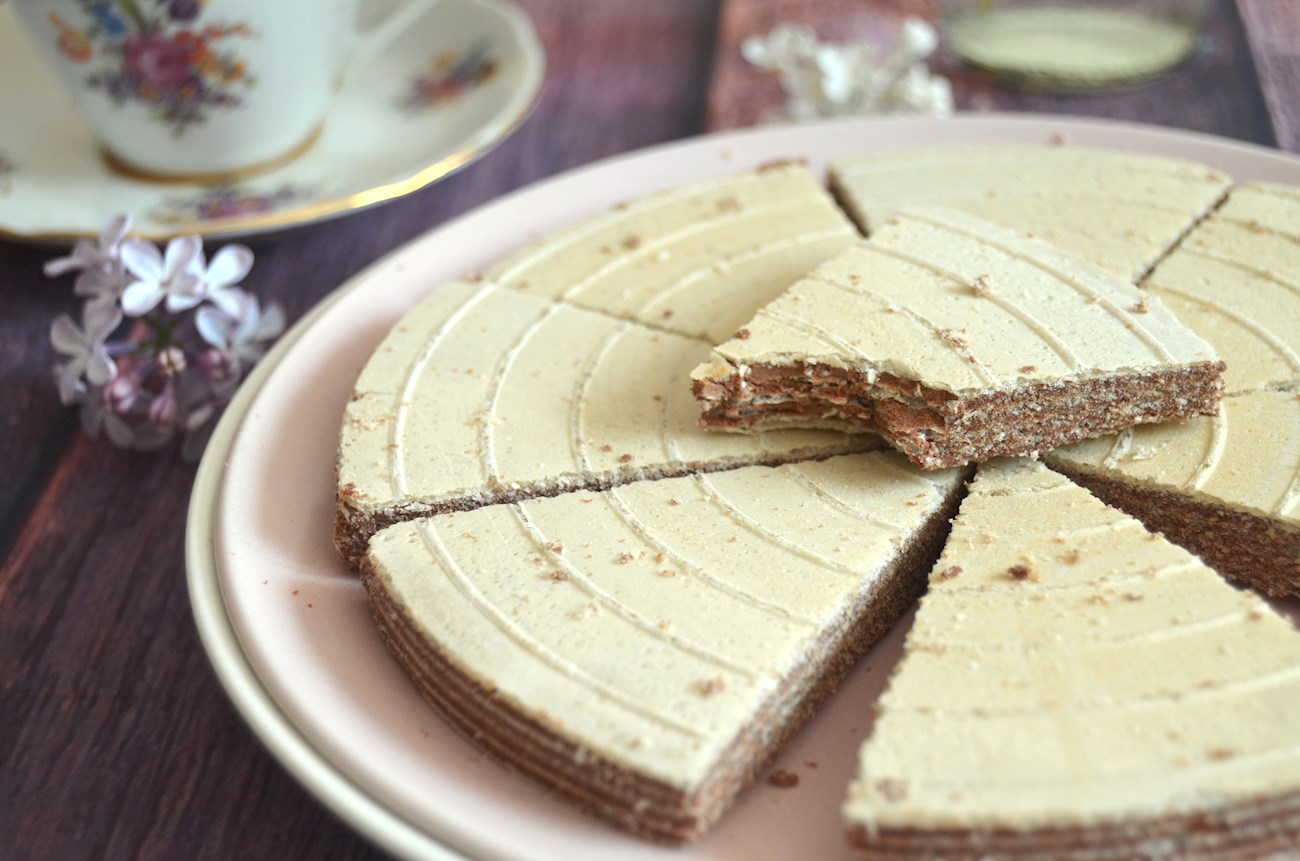Karlovarské oplatky are flat wafers made according to an old, traditional recipe in the area of Karlovy Vary in the Czech Republic since the mid-18th century when they were originally homebaked. As evidence, today there are the oldest wafer-making irons in the Karlovy Vary Museum.
In the past, cooks would make wafers sprinkled with sugar for the guests of the Karlovy Vary spa. The wafers have a diameter of 19 centimeters and, in the middle, there is a water fountain or a chamois, a symbol of the spa town. The thermal spring water is used in the production process, acting as a moisturizer for the wafers.
Karlovarské trojhránky are traditionally made wafers, produced from the Karlové oplatky wafers when they are cut in eight pieces, forming small triangles and can be sold either individually or in batches of several pieces. They are produced in the area of Karlovy Vary in the Czech Republic since the mid-18th century, when they were originally home-baked.
The whole wafers have a diameter of 19 centimeters and, in the middle, there is a water fountain or a chamois, a symbol of the spa town. Thermal spring water is used in the production, acting as a moisturizer for the wafers. They are sprinkled with sugar, hazelnuts, almonds, cocoa, vanilla or cinnamon, and then baked until they are crisp, thin and develop their characteristical flavor and scent.
MAIN INGREDIENTS
Mariánskolázeňské oplatky are wafers with an unusually large and round shape, produced in the municipalities of Mariánské Lázně and Velka Hled'sebe in the Czech Republic since 1856. The final product consists of two thin wafers glued together by a layer of filling, which can be made with hazelnuts or cocoa.
The edge is crumbled, and the wafers break with a characteristical crack once they are bitten into. The wafers are either light brown or cream in color, consisting of wheat flour, sugar, egg yolks, salt, starch, and flavorings. The fillings have a texture that is granular, while the flavor is delicately sweet.
Krumkake are traditional Norwegian wafer cookies. The batter is made with a combination of eggs, sugar, vanilla, flour, baking powder, cardamom, and butter. Once prepared, the batter is cooked on a special griddle that imprints the wafers with a visually attractive design.
After they've been baked, these wafer cookies are rolled, then often filled with whipped cream and dusted with powdered sugar. Krumkake are prepared and consumed throughout Scandinavia, and they're especially popular during the festive Christmas season.
Hořické trubičky are rolled wafers produced in the town of Hořice and neighbouring municipalities in the Czech Republic. The rolls are from 5 to 19 centimetres long and light beige in colour. They have the scent and taste of a wafer, with a crunchy, smooth and porous texture.
The wafers are made from only six ingredients - wheat flour, powdered milk, sugar, water, egg yolks and vegetable oil. They come in different varieties, so the rolls can be filled, half-coated, coated and sprinkled. When filled, the filling consists of whipped butter cream with cocoa powder and vanilla.
Andruty kaliskie, also known as Kalisz wafers, are thin, sweet and crisp cream-colored wafers with a shiny surface produced in the city of Kalisz in Poland since the 19th century. They have become a symbol of the town in the Wielkopolska region.
To achieve their delicate, dry, crisp and smooth taste, water, sugar, flour and rapeseed oil are mixed to form a dough that is then pressed between the two plates of a traditional waffle iron. In the past, they have regularly been sold on Sundays and holidays at the park in Kalisz and were a favorite snack of families on their outings.
MAIN INGREDIENTS
Kniepertjes are a traditional Dutch treat popular in the northeastern provinces of the Netherlands, particulary Drenthe, during the holiday season. These thin, crispy, wafer-like cookies are made from a simple batter of flour, butter, sugar, and eggs, often flavored with vanilla, cinnamon, or anise.
Kniepertjes hold symbolic meaning tied to the New Year. The flat versions represent the old year, symbolizing that it has been fully "unrolled," while rolled Kniepertjes, shaped into a cylindrical roll resembling a waffle cone, represent the new year, which is yet to "unfold." They are made using a special waffle iron called a kniepertjesijzer or a flat waffle press.
TasteAtlas food rankings are based on the ratings of the TasteAtlas audience, with a series of mechanisms that recognize real users and that ignore bot, nationalist or local patriotic ratings, and give additional value to the ratings of users that the system recognizes as knowledgeable. TasteAtlas Rankings should not be seen as the final global conclusion about food. Their purpose is to promote excellent local foods, instill pride in traditional dishes, and arouse curiosity about dishes you haven’t tried.





